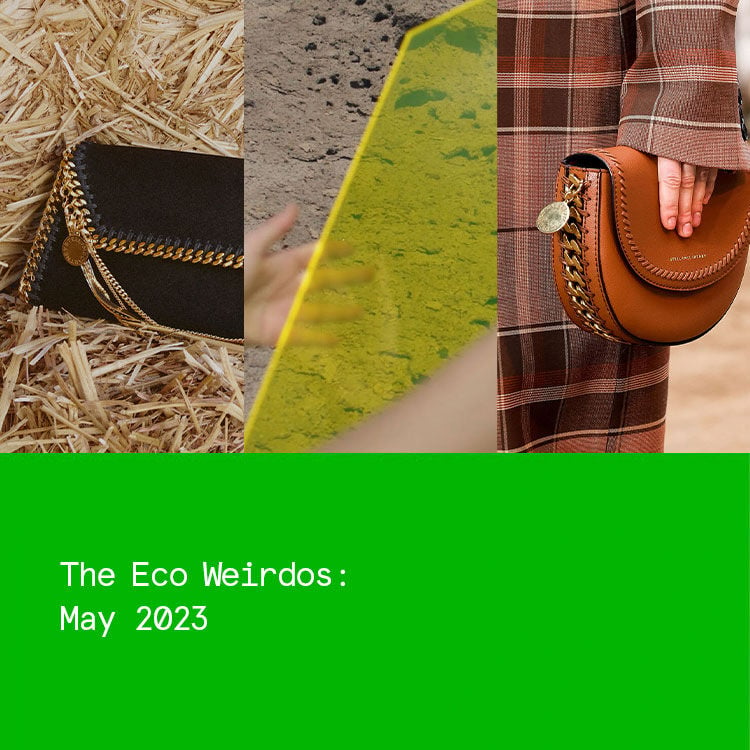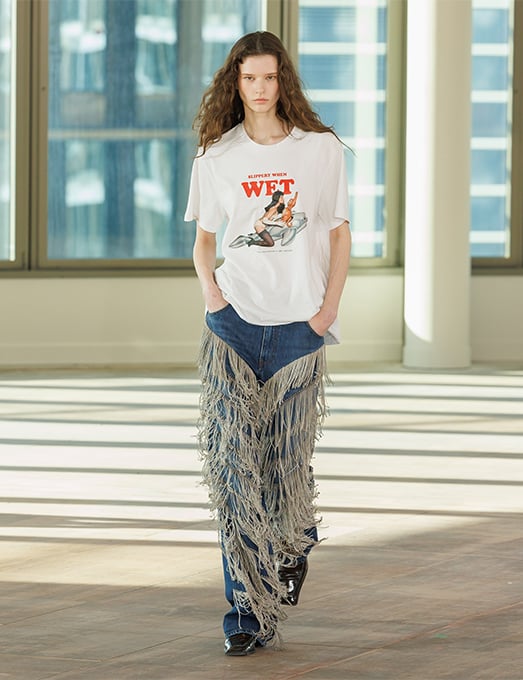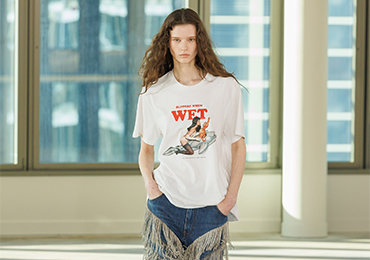The Eco Weirdos: How fashion lifecycles impact our planet and how to extend them
Welcome to The Eco Weirdos, a monthly column from Stella McCartney.
This May, we are inspired by spring’s longer and brighter days. The fashion industry contributes drastically to the global climate emergency: CanopyStyle shares that 150 million trees are logged annually to make fabric, conventional cotton production accounts for 16% of all pesticide use – degrading arable soil – and, according to the British Council, more than 150 billion items of clothing are produced each year. The industry is a pollutant in several ways. Still, the British Council estimates the ‘average British household leaves a third of their clothes unworn each year and collectively we send 300,000 tonnes to landfill’. We are in the midst of an overconsumption crisis. This month, we are distilling what product lifecycles are and why we believe in extending our product lifecycles for as long as possible.
How fashion lifecycles impact our planet and how to extend them
The lifecycle of a product is simply the length of time that covers the stages that a product goes through during its lifetime, beginning with its development and ending in its decline or end-of-use. And, due to the complexities of producing clothing, fashion has a longer and more complicated lifecycle than most – involving fibre and yarn production, design, assembly, transportation and beyond.
As the demand for fashion surges, product lifecycles are becoming shorter and shorter. The trajectory from trend prediction to product availability is faster than ever – with fast fashion brands achieving super-speed turnarounds on collections, made in locations with poor workers’ rights and from low-quality synthetic materials. The World Bank suggests that global clothes sales could increase by up to 65% by 2030 and, thanks to the accessibility of fast fashion, today people spend less than a fifth while purchasing over double the amount than they did 20 years ago.
According to Oxfam, the average Brit has 57 unworn items in their wardrobe. As the fashion industry and trends speed up, the result is that over half of all clothing produced is disposed of within years of being made. Science Direct state that 73% of clothing ends up in landfills and incinerators. In turn, when products are destroyed, it wastes the energy and resources originally used to produce them.
The Ellen MacArthur Foundation estimates that the destruction of unsold items generates between 5 and 20 times more greenhouse gas emissions than with reuse. This is not good enough and we know there can and must be a better way. It begins with moving to a circular economy: one where the clothes we produce and love will be restorative by design – never ending up as waste.
Our sustainable vision is guided by and accountable to our bold values – making every action count. We stand up and speak up for Mother Earth, animals and in solidarity with all humans. As well as protecting our fellow creatures and pioneering material innovations, we design with sustainability in mind – so we can extend the lifecycle of our products – and place a huge emphasis on transparency and social responsibility to all the workers in our supply chain.
How to extend the lifecycle of your products
Re-wear your wardrobe
We are embracing circular business models that will transform how clothes are sourced, produced, sold, shared, repaired and reused. Our aim is to design long-lasting products that have an extended use to reduce environmental impact. Made with quality input – and as much quality recycled input as possible – we create pieces that are made to be worn and cherished forever. According to research conducted by Leeds University and Arup, ‘buying a maximum of only eight new items a year could reduce fashion's emissions by 37% in the world's major cities’.
Stella’s foundational staples are made for every Stella woman, forming the pieces they cannot be without: Savile Row tailoring, organic and regenerative cotton t-shirts, denim made from organic and Humana cotton, iconic handbags and shoes and beyond.
Clevercare initiative
Originally introduced at the Copenhagen Fashion Summit in 2014, Clevercare is our unique garment labelling system – reminding us all to consider the environment when washing and caring for our clothes. Clevercare covers simple clothing care tips to help extend the lifecycle of our products, decreasing the amount of pieces that end up in landfill and reducing your environmental footprint.
- Washing: Washing clothes regularly uses an incredible amount of water and, more often than not, airing or brushing your pieces are enough to keep them clean. For small stains, consider spot cleaning.
- Temperature: A simple way to extend the life of your clothes is to wash them at a lower temperature. Studies recommend washing clothes at 30°C rather than 40°C – this small change in temperature reduces electricity consumption by approximately 40% and provides better care for your clothing.
- Drying: Tumble drying accounts for around 60% of the energy used during laundering. We recommend hanging your clothes up to dry wherever possible – it's much better for the environment and for your clothes. Washing cotton garments at lower temperatures, and then air-drying them, reduces total lifecycle energy consumption by two times.
- Ironing: Consider ironing only when absolutely necessary. Often, you can avoid creases and folds on your garments by taking air-dried laundry with you into the bathroom while showering. Hang it on the back of the door: the steam from your shower will naturally remove creases, saving effort and conserving energy from ironing, while protecting clothes from being compressed.
- Dry cleaning: When it comes to dry cleaning, the best option is to look for an eco or green dry cleaner. The chemicals used by most dry cleaners can harm air quality, the health of employees and your own wellbeing. Remember: cashmere, cotton and most wools are easily hand-washed in the sink or on a delicate cycle.
Donate and resell your pieces
Charity shops and consignment websites are key to extending the lifecycle of your clothes. Because we never want garments to end up in landfill, we do everything we can to ensure items live a long life. If you are finished with your clothing or accessories and they are in good condition, you could donate them to a charity shop that supports a cause close to your heart, allowing somebody else to restart their lifecycle. We also recommend giving them to a friend or selling them through a consignment site like The RealReal so that someone else can love them. Alternately, you can recycle them so they can get a second life as new textiles.
Recycle
Despite our best efforts, we must sometimes get rid of pieces in our wardrobe because they no longer fit or are no longer fit for purpose. We see textile recycling as a last-resort solution. At present, the Ellen MacArthur Foundation estimates that less than 1% of our clothing is recycled globally. Within the world of recycling come all manner of other issues: quality, longevity and how easy it is to further recycle recycled materials.
Recycled materials may not always lead to a more circular economy. A majority of recycled polyester, for example, is crafted from PET bottles rather than from pre-loved clothing, which makes it difficult to be recycled again. It is important to consider the quality of the fibres being recycled, too, since when fibres are recycled, the yarns become shorter each time. Earlier this year, we launched the Close-the-Loop Parka in ECONYL® yarn, piloting a takeback scheme with Aquafil. This pioneering parka is crafted from waste and designed to never become waste again.
In our Stella vision, all materials will be created using regenerative systems designed to restore our planet or use close-the-loop circular materials. It is our hope that all materials can one day either biodegrade harmlessly or be captured and recycled infinitely.





